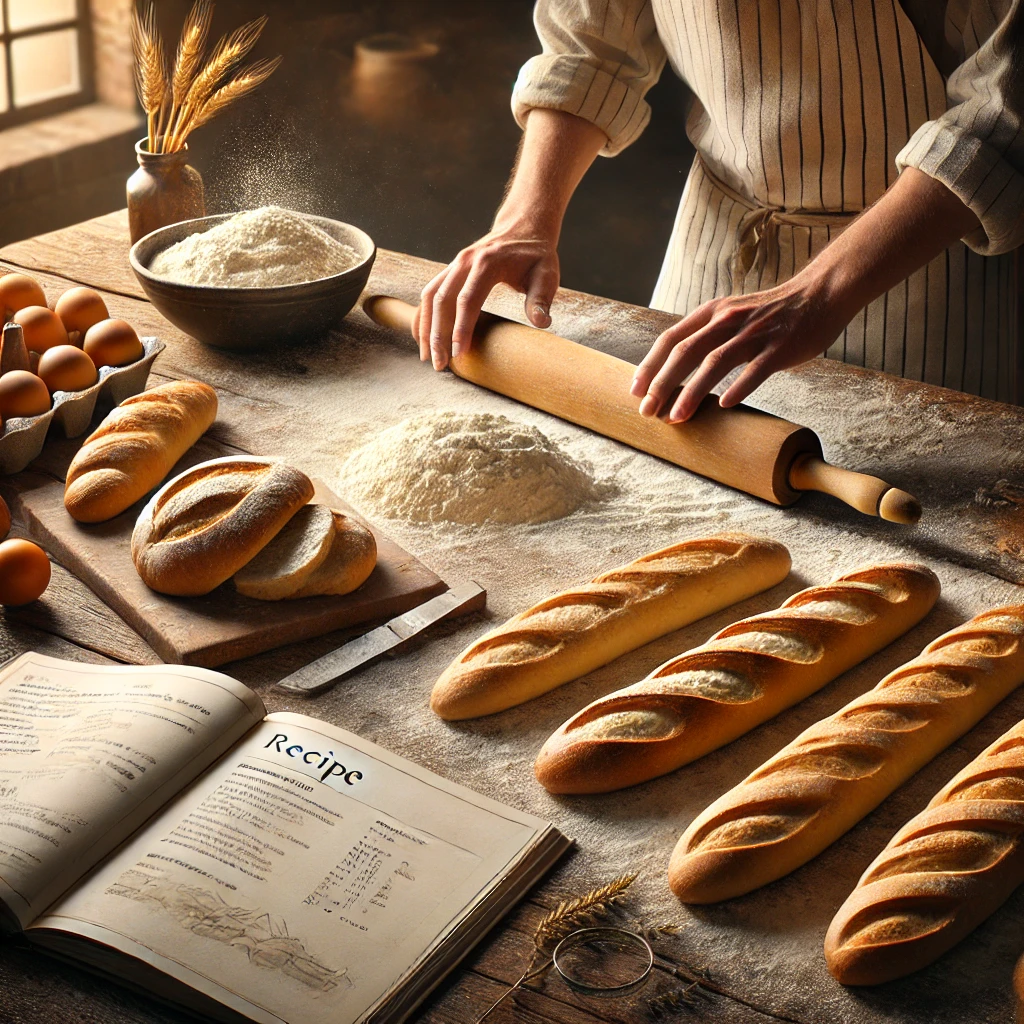There’s something magical about the aroma and texture of freshly baked French bread. With its crispy crust, chewy interior, and simple ingredients, this classic loaf—often shaped as a baguette—is both iconic and incredibly satisfying to make at home.
Whether you’re a beginner or looking to refine your skills, this guide will walk you through each step of making authentic French-style bread from scratch, using ingredients and tools available in most home kitchens.
1. Ingredients: Keep It Simple
French bread is all about simplicity. The traditional recipe calls for just four ingredients:
- Flour (preferably bread flour for better structure)
- Water
- Salt
- Yeast (instant or active dry)
Basic recipe (makes 2 loaves):
- 500g bread flour (about 4 cups)
- 350g water (about 1 ½ cups)
- 10g salt (2 tsp)
- 2g instant yeast (½ tsp)
No sugar, oil, or additives—just time and technique.
2. Mixing and Autolyse
Begin by combining the flour and water (without salt or yeast) in a large bowl. Stir until there are no dry patches. This step is called autolyse, and it helps hydrate the flour and kickstart gluten development.
Rest time: 20 to 30 minutes covered with a towel or lid.
After the rest, add salt and yeast. Mix until well incorporated. You don’t need to knead heavily—stretch-and-fold techniques work well here.
3. First Fermentation (Bulk Rise)
Transfer the dough to a clean bowl or container and let it rise.
Time: 1.5 to 2.5 hours at room temperature (70–75°F / 21–24°C)
During this time:
- Do stretch-and-folds every 30–45 minutes (lift one side of the dough and fold over itself, rotating as you go).
- This develops gluten gently without kneading.
The dough should become smoother, puffier, and more elastic over time.
4. Pre-Shaping and Rest
Once the dough has roughly doubled in size, turn it out onto a lightly floured surface.
- Divide into 2 equal pieces.
- Shape each piece into a loose ball.
- Let rest uncovered or lightly covered for 15–20 minutes. This relaxes the dough and makes final shaping easier.
5. Final Shaping (Baguette Style)
Now it’s time to shape your dough into classic French loaves.
Steps:
- Gently flatten one dough ball into a rectangle.
- Fold the top third down, then the bottom third up (like folding a letter).
- Roll into a log, gently elongating it to about 12–14 inches.
- Pinch the seam and place seam-side down on parchment or a floured couche (linen cloth).
Repeat with the second piece.
Proof time: 45 to 60 minutes, until slightly puffy but not doubled.
6. Scoring the Loaves
Just before baking, use a sharp razor blade or bread lame to score each loaf with 3–5 diagonal cuts. This allows the bread to expand in the oven without tearing.
Tip: Mist the blade with water and use a confident, swift motion.
7. Baking with Steam
French bread needs steam to form that thin, crispy crust.
Oven setup:
- Preheat to 475°F (245°C) with a baking stone or inverted baking sheet inside.
- Place an empty metal tray on the bottom rack.
Bake:
- Transfer loaves onto the hot stone or tray.
- Quickly pour ½ cup of hot water into the lower tray and close the oven door.
- Bake for 20–25 minutes until deeply golden and crisp.
Optional: Remove the steam tray after 10 minutes for a drier crust.
8. Cooling and Slicing
Let your loaves cool on a wire rack for at least 30 minutes before slicing. This allows the crumb to finish setting and avoids a gummy interior.
Listen closely—you might hear the crust “singing” as it crackles and contracts.
9. Tips for Success
- Use bread flour: Higher protein gives better chew and structure.
- Don’t rush proofing: Underproofed dough won’t rise properly; overproofed dough may collapse.
- Use a scale: Accuracy improves consistency and quality.
- Practice shaping: The more you do it, the easier it gets.
- Steam matters: Without it, the crust won’t develop properly.
10. Storing and Serving
- Store cooled bread in a paper bag or linen wrap for up to 2 days.
- To refresh, reheat in a 350°F oven for 5–8 minutes.
- Slice and freeze for longer storage.
Serving ideas:
- With cheese and wine
- As garlic bread
- For bruschetta or crostini
- Simply with butter and jam
Final Thoughts
French bread may look fancy, but it’s one of the most satisfying breads you can make at home—no special tools required. With a little patience and practice, you’ll be baking loaves that are crisp on the outside, soft inside, and full of flavor.
Bon appétit!
